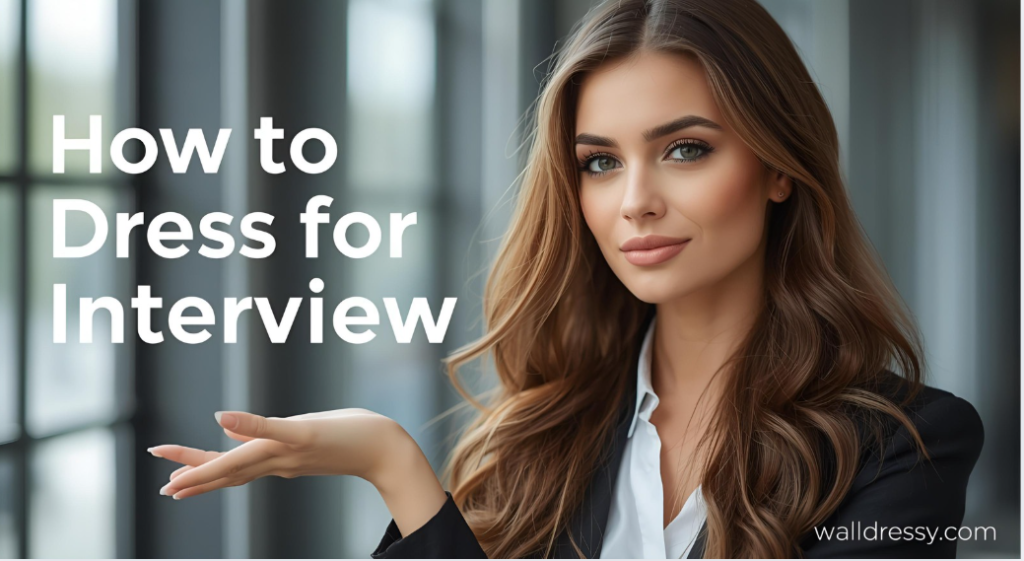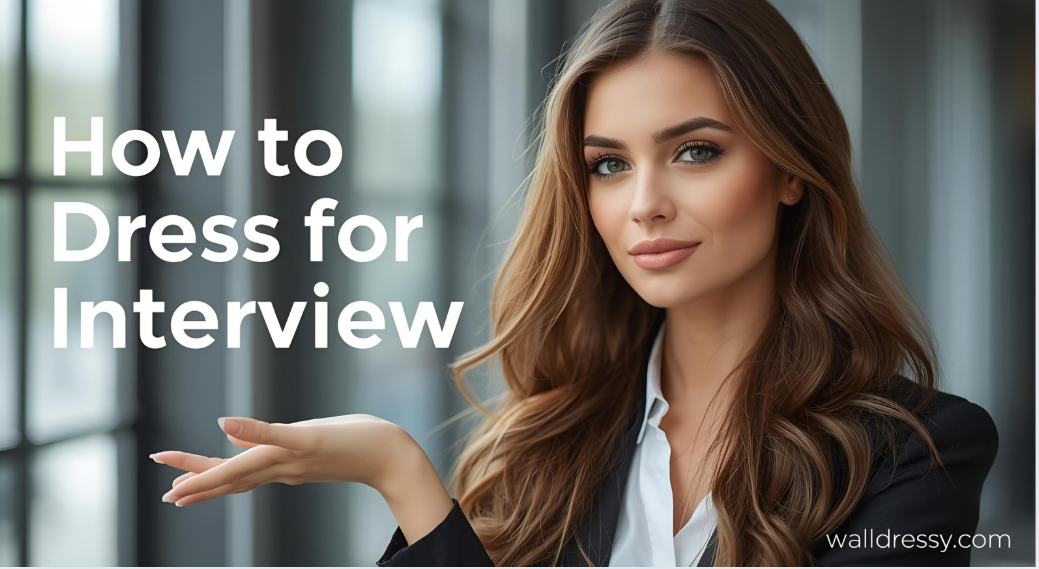First impressions matter more than most people realize, and nowhere is this more true than in a job interview. From the moment you walk into the room (or appear on screen in a virtual interview), your interviewer is assessing not only your communication and qualifications but also your presentation. Knowing how to dress for interview situations is one of the most important aspects of career preparation.
Your attire communicates professionalism, attention to detail, and respect for the company. It also reflects how seriously you take the opportunity. The challenge is that expectations vary depending on the industry, company culture, position level, and even the format of the interview. A candidate who wears the perfect suit for a corporate role may be overdressed for a creative startup, while someone who dresses casually for a formal office may come across as careless.
This article is your complete 2000-word guide to how to dress for interview occasions. We’ll cover dress codes, gender-specific tips, outfit examples, grooming essentials, and even what to avoid so you can stand out in the best way possible.
Why Dressing Right for an Interview Matters

The way you dress affects not only how interviewers perceive you but also how confident you feel. Studies show that people perform better when they dress the part because attire influences mindset. Dressing professionally creates an aura of competence, reliability, and readiness for responsibility.
When you know how to dress for interview success, you’re not just picking clothes—you’re strategically shaping perception.
Understanding Dress Codes Before an Interview
One of the biggest mistakes job seekers make is assuming a “one-size-fits-all” approach. Not every company expects a full suit and tie. Decoding the dress code is step one.
1. Formal/Corporate Interview Attire
- Common in law, finance, government, consulting, and executive positions.
- Suits are expected for both men and women.
- Neutral colors like navy, black, or charcoal are best.
2. Business Professional
- Slightly less formal than corporate attire but still structured.
- Men can wear suits without a tie, or slacks with a blazer.
- Women can opt for tailored dresses, skirts with blouses, or pantsuits.
3. Business Casual
- Popular in tech, marketing, startups, and creative industries.
- Men may wear chinos with a button-down shirt and loafers.
- Women can choose blouses with dress pants or modest dresses.
4. Casual or Creative Workplace
- Found in design, fashion, and some startups.
- Style and individuality are appreciated, but avoid overly casual pieces like shorts or flip-flops.
- Think neat, polished, and aligned with the brand’s culture.
5. Virtual Interviews
- Dress the same as you would for in-person.
- Focus on solid colors that work well on camera.
- Avoid distracting patterns or noisy accessories.
How to Dress for Interview: Men’s Guide
Suits and Jackets
A well-fitted suit is the safest option for formal interviews. Navy and charcoal are universally flattering. Jackets should fit snugly at the shoulders and taper at the waist without being too tight.
Shirts
Classic button-down shirts in white, light blue, or subtle stripes are ideal. They should be clean, pressed, and tucked in neatly.
Ties
Conservative ties in solid colors or subtle patterns (stripes, dots) add polish. Avoid loud novelty ties that distract.
Pants
Flat-front trousers are modern and professional. They should break slightly above the shoe without bunching.
Shoes
Leather oxfords, derbies, or loafers in black or brown are best. Keep them polished.
Accessories
- Belt should match your shoe color.
- Watches should be simple and professional.
- Minimal jewelry is better.
How to Dress for Interview: Women’s Guide
Suits and Jackets
Pantsuits or skirt suits in dark neutrals are versatile choices for formal interviews. Blazers should be fitted but not restrictive.
Dresses and Skirts
A sheath dress with a blazer is a professional alternative. Skirt lengths should be around knee-length—never too short.
Blouses and Tops
Solid colors or subtle patterns work best. Avoid low necklines or overly sheer fabrics. Soft neutrals like cream, blush, and pastels are safe bets.
Pants
Tailored dress pants in dark shades are ideal. Avoid overly tight fits or casual leggings.
Shoes
Closed-toe heels or flats are the standard. Heels should be modest (2–3 inches). Avoid sandals or overly flashy footwear.
Accessories
- Structured handbags or totes are best.
- Jewelry should be subtle—stud earrings, thin chains, or classic watches.
- Scarves can add polish if used sparingly.
Grooming and Personal Presentation
How you dress is only part of the equation. Grooming and hygiene are equally important.
- Hair: Should be clean and neat. Men should trim facial hair or keep it well-groomed.
- Nails: Clean and trimmed. Women can wear neutral polish, but avoid neon or chipped nails.
- Fragrance: Light and subtle—overpowering cologne or perfume is distracting.
- Makeup: Natural, professional, and enhancing rather than dramatic.
- Posture: Standing tall and carrying yourself confidently completes the professional look.
How to Dress for Interview by Industry
Different industries carry different expectations, and knowing this can set you apart.
Finance, Law, Government
- Stick with conservative formal suits.
- Dark colors, crisp shirts, and professional shoes.
Tech and Startups
- Business casual is standard.
- Polished chinos, smart shoes, and blazers work well.
Creative Fields (Design, Marketing, Media)
- Business casual with a stylish twist.
- Add a pop of personality with accessories or subtle colors.
Retail, Hospitality, and Customer-Facing Roles
- Business professional attire shows readiness to interact with clients.
- Choose approachable colors and clean lines.
Skilled Trades and Manufacturing
- Clean, neat attire without excess formality.
- Polo shirts, pressed slacks, or button-downs show professionalism without overdressing.
How to Dress for Interview According to Season
The weather impacts your comfort and clothing choices.
Summer Interviews
- Lightweight fabrics like cotton, linen, or blends.
- Light colors like gray, beige, or pastel shirts.
- Women can wear short-sleeved blouses with blazers.
Winter Interviews
- Wool suits, layered sweaters, and darker colors.
- Overcoats and scarves should remain professional.
- Women can wear tights with skirts or dresses.
Spring and Fall Interviews
- Transitional fabrics like twill, blends, or light wool.
- Layers (sweaters, vests) allow flexibility.
- Neutral tones paired with subtle seasonal colors work well.
Common Mistakes to Avoid
When learning how to dress for interview, it’s just as important to know what not to do.
- Wearing wrinkled or stained clothes.
- Choosing overly casual attire like hoodies, jeans, or sneakers.
- Wearing too much perfume or cologne.
- Flashy jewelry or distracting accessories.
- Ill-fitting clothes—too tight or too baggy.
- Shoes that are scuffed, dirty, or overly casual.
Outfit Examples for Men
- Corporate Role: Navy suit, white dress shirt, dark tie, black oxford shoes.
- Business Professional: Charcoal blazer, light blue shirt, gray trousers, brown loafers.
- Business Casual: Chinos, button-down shirt, leather belt, loafers.
- Creative Role: Slim trousers, patterned shirt, blazer, clean sneakers or loafers.
Outfit Examples for Women
- Corporate Role: Black pantsuit, cream blouse, closed-toe heels.
- Business Professional: Pencil skirt, button-down blouse, fitted blazer, pumps.
- Business Casual: Dress pants, knit top, cardigan, flats.
- Creative Role: Sheath dress with blazer, statement necklace, block heels.
Virtual Interview Dressing Tips
Since many interviews now happen virtually, presentation is still critical.
- Choose solid colors that contrast with your background.
- Avoid stripes or patterns that distort on camera.
- Keep accessories minimal to avoid distractions.
- Grooming and lighting are as important as attire.
- Dress fully—head to toe—because you never know when you might need to stand up.
How to Build an Interview Wardrobe on a Budget
Looking professional doesn’t have to mean overspending.
- Capsule Wardrobe: Invest in a few quality basics (one suit, two shirts, one pair of shoes). Mix and match.
- Neutral Colors: Black, navy, gray, and white are versatile.
- Secondhand Options: Thrift stores and online resale platforms often have high-quality suits at lower prices.
- Tailoring: A tailored inexpensive suit often looks better than an ill-fitting expensive one.
Dressing With Confidence
Frequently Asked Questions (FAQs)
1. What is the safest outfit to wear to an interview?
A tailored suit in a neutral color (navy, black, or gray) with a crisp shirt and polished shoes is the safest choice, especially for formal industries. For less formal roles, business casual such as slacks with a blazer and dress shoes is a safe option.
2. Can I wear jeans to an interview?
Unless explicitly told otherwise, avoid jeans. Even if the company has a casual dress code, jeans may appear too relaxed for a first impression. Opt for chinos, trousers, or a dress.
3. Should I always wear a tie to an interview?
For formal and business professional roles, yes. For business casual or creative industries, a tie may not be necessary but having one available shows flexibility.
4. How important are shoes in an interview outfit?
Shoes complete the look and can make or break a professional impression. Scuffed or casual shoes can signal carelessness. Always wear clean, polished dress shoes.
5. Is it okay to wear bright colors to an interview?
Subtle pops of color (like a tie, scarf, or blouse) can add personality. However, avoid overly bold patterns or neon shades that may distract from your professionalism.
6. Can I accessorize for an interview?
Yes, but keep it minimal. A watch, simple earrings, or a small necklace works well. Avoid flashy or noisy accessories.
7. What should women avoid wearing to interviews?
Avoid overly short skirts, low-cut tops, flashy jewelry, or overly casual shoes like sandals. Outfits should be professional, modest, and aligned with company culture.
8. Should I dress differently for a virtual interview?
Dress as you would for an in-person interview, but choose solid colors that look good on camera and avoid distracting patterns. Grooming and background setup matter just as much as clothing.
Conclusion
Learning how to dress for interview opportunities is about striking the right balance between professionalism, confidence, and company culture. The right outfit not only creates a strong first impression but also boosts your own self-assurance during one of the most important moments in your career journey.
For traditional industries like law, finance, and government, formal suits remain the gold standard. Business casual attire works for many modern workplaces, while creative fields allow for subtle personal flair. Whether in-person or virtual, your attire should always be clean, polished, and well-fitted.
Remember, your clothes speak before you do. A well-chosen outfit signals respect, preparation, and the ability to represent yourself and the company professionally. By planning ahead, understanding dress codes, and paying attention to grooming, you set yourself up for success.
At the end of the day, interviews are about more than just answering questions—they’re about showing that you’re the right fit. Dressing with intention helps ensure that your first impression works in your favor and brings you one step closer to landing the role you want.

